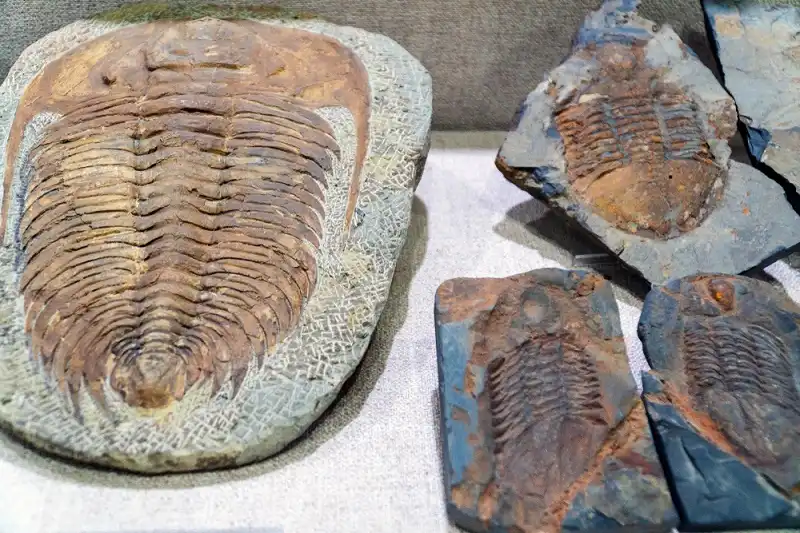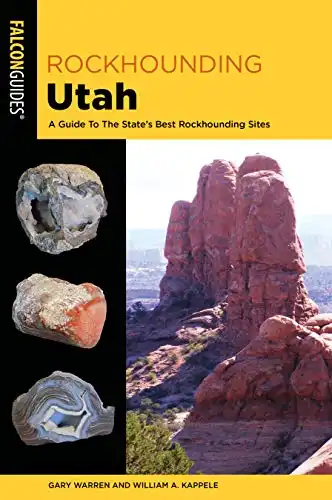Trilobite Fossils in Utah
The number of sites and varieties of fossil genre found throughout the western states is mind-boggling. In
Trilobites are most commonly found in shale or mud deposits, where they can be revealed by splitting rocks and by close scrutiny of muddy areas. Specimens vary from a few mm to over 30 cm (12 inches). Most
You will want to bring containers appropriate for transporting various sized findings. It’s difficult to find information about the accessibility of lesser-known sites. You may want to check with the Bureau of Land Management (BLM) if you are interested in visiting areas that are not publicly advertised. Permits or professional qualifications may be required for some formations.
There are sites that have been highly advertised for public collecting, and others that remain for the most part hidden from the public eye. For the record, here are some of the most abundant areas for trilobite fossil deposits in
Just how and when did trilobites become extinct? Here are two different theories of how and when this might have happened.
1.U-Dig Trilobite Quarry
This privately-owned Millard County location is located in the House Range in a formation known as the Wheeler Amphitheater. The site is about 50 miles west of Delta, near Antelope Springs.
The House Range is considered to hold one of the densest deposits of Cambrian trilobites in the world, so you’re pretty much guaranteed to come away with at least a few specimens.
Entry fees depend on how many hours you plan to spend. Check the website for specifics. There are discounts for large groups,
In some areas, heavy equipment excavators regularly expose fresh rock for less-experienced rockhounds. U-Dig provides necessary tools for digging, but you’ll still need to bring your own gloves and containers for transport. The site provides digging instructions and experienced staff to assist newbies with their search.
You’ll need to provide your own food and water, though there are shaded sitting areas and toilet facilities. There’s no camping on-site, but surrounding BLM lands allow free rough camping. Small RVs can make it into the site’s parking area. Larger RVs will have to be parked on the main road, about 500 yards from the site office.
2. A New Dig
Not far from U-Dig is the ‘A New Dig‘ site. This site is a bit more exclusive, and reservations are required. The most common trilobite species found here is Elrathia Kingii, a striking, black species that can be found in jewelry-grade at this site.
The rates at A New Dig can be a bit higher. Fees vary according to the person and time, with several choices explained on the website. Children 12 and under are free with a paying adult. Spaces are limited, so plan ahead for this outing.
Tools and assistance are also provided at the site. Some of the staff have as much as 40 years experience to share with visiting rockhounds. Specimens from the site are also available online for anyone looking for a quality specimen as a gift for a rockhound friend.
3. BLM Trilobite Quarry
This third Millard County site is also located west of Delta, northeast of the two sites listed above. The GPS coordinates are available on the website. BLM Trilobite Quarry is a completely free public site. As an undeveloped site, it may take a bit more hiking and effort to make desired finds.
The road to the site is rough and rutted, so only come if your vehicle can handle off-road conditions. Several miles of dirt road wind through the valley to the quarry, which is itself about an acre in size.
Visitors will find the site has been worked on several levels. Some of the darker shale is pretty tapped out, but there are scrap piles everywhere. Some visitors have reported having better luck in areas of dried mud. Specimens are washed into gullies during the periodic rainfalls. Some specimens are truly tiny, others dime or penny size, so bring your magnifying glass for this one.
You’ll need to bring everything you need for this and the following sites. There is no development or assistance in these areas.
4. Weeks Formation
Also found in the House Range, but not so accessible, is the Weeks Formation, an outcrop in the North Canyon near Notch Peak. Major finds in this formation are so new that they are still being categorized before being officially published. There are many species to be found in the area.
This is not an area recommended for beginners. Experienced trilobite collectors will want to further research the success of the site, but just knowing it’s in the House Range makes it a part of trilobite heaven.
5. Wellsville Mountains
It would be hard to list all the little pockets of trilobite-rich shale in
The vast majority of Spence shale deposits are located on BLM lands. That means that they are open to the public for private collecting, but not for commercial use, up to 25 pounds per day. Other BLM guidelines can be found online.
These sites are recommended for those able to walk and climb easily while transporting any needed gear into the area and any finds away from the area. A fair number of trilobite specimens have been found here, some quite large. Visiting this area could be an outing of several days for experienced backpackers.
- Completely updated and revised
- Full color images
- Each description of the 86 state's sites includes concise information on the material to be found there, the tools to bring, the best season to visit and what type of vehicle to drive.
Something for Everybody
Whether you’re a beginner seeking your first trilobite specimen or an experienced rockhound looking for a challenge,
(VIDEO) Hunting For Trilobites in Utah
Read More
- 10 Different Types Of Trilobites (Identifying Trilobite Fossils)
- When Did Trilobites Become Extinct? (Are They Alive Today?)
- Isotelus Rex | The Largest Trilobite Fossil Ever Found
- 7 Of The Largest Gold Nuggets Ever Found…Ever! - December 21, 2023
- Find Gold On Your Property? Here’s Why You Should Think Twice Before Spreading the News - December 21, 2023
- The Opalized Crab Claw (And How It Formed) - September 14, 2023
- Online rock and mineral club for collectors of all levels!
- Find community with like-minded rock and mineral enthusiasts.
- Monthly Giveaways!
- Free Access to Entire Digital Library of Products (current and future products)*




